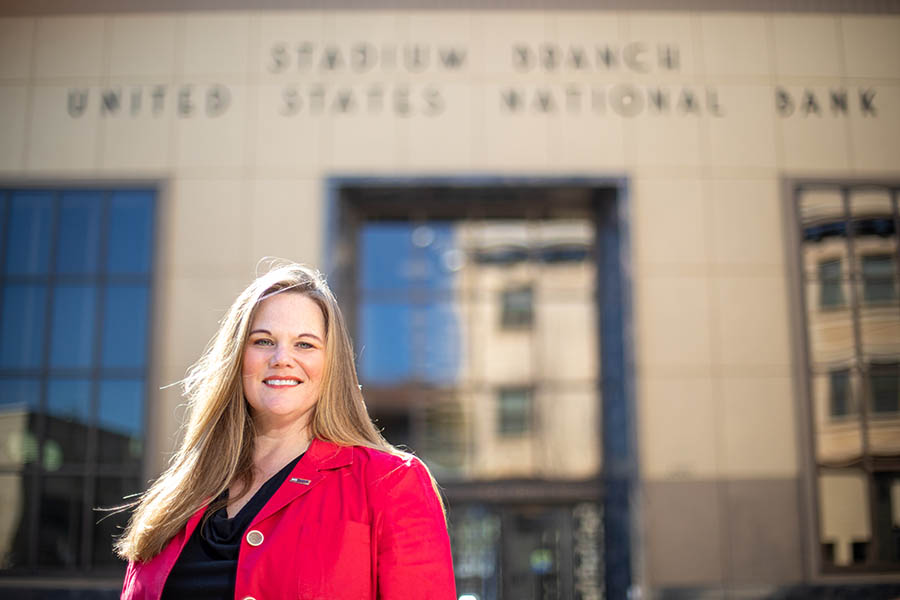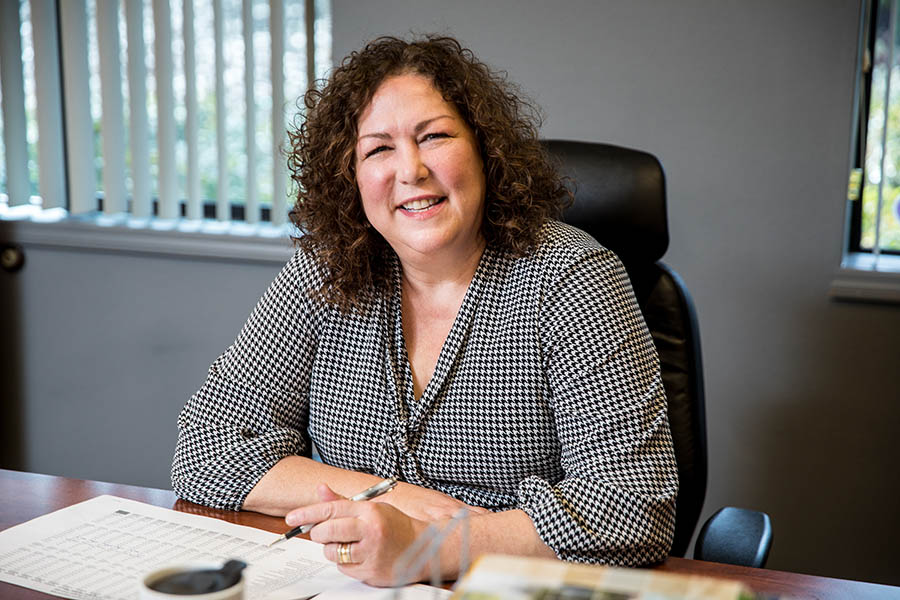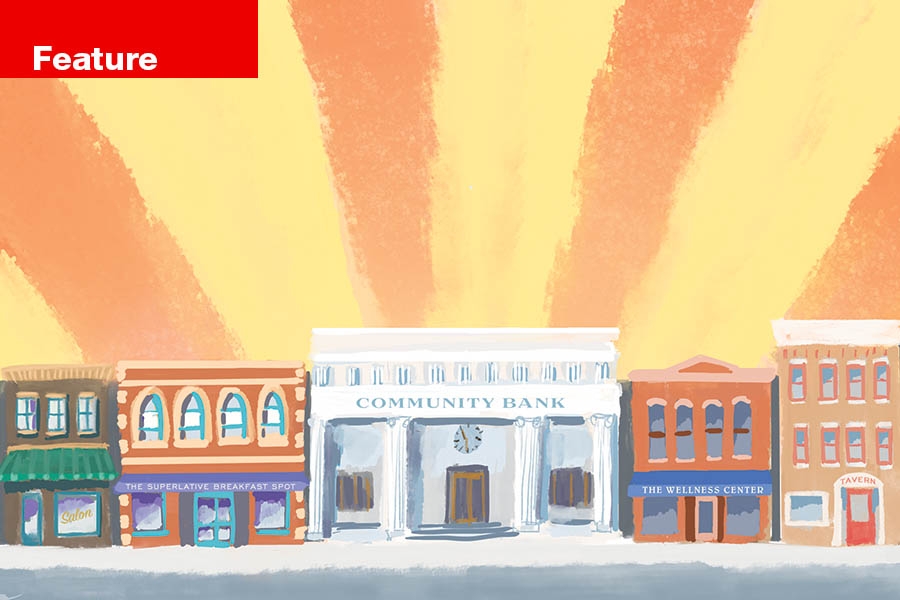Paycheck Protection Program loans provided lifelines to Oregon’s small businesses but triggered messy headaches for banks. A look back at the process proves the struggle paid off in many ways.
Paycheck Protection Program (PPP) loans offered a desperately needed helping hand to Mitch and Cathy Teal, owners of BREW Coffee and Taphouse in Independence and West Salem. Their business, like all service providers — restaurants, salons, medical offices and the like — was hurting from restrictions imposed to stop the spread of COVID-19.
The cash infusion (basically free money from the federal government if you followed the rules) promised some relief. Securing the loan, however, was messy and stressful from the start.
“Our regular bank, Maps Credit Union, did not offer the program,” says Cathy Teal, “so we had to find another.”
Teal heard that a larger bank, Washington Federal, was offering the loans to noncustomers. Even better, Teal had a personal connection with an employee at a nearby branch. “Our kids go to school together,” she says. Teal’s friend introduced her to the right person at Washington Federal who “held my hand through the process.”
And what a process.
Securing that first loan through the PPP was arduous for Teal. She was beset by incorrectly formatted documents and bedeviled by constantly changing rules, and feared that available funds would run out in the first-come, first-served system.
 Mitch Teal, co-owner of BREW Coffee and Taphouse Photo: Jason E. Kaplan
Mitch Teal, co-owner of BREW Coffee and Taphouse Photo: Jason E. Kaplan
Teal and her husband eventually secured a $45,000 loan in that harried first round, using the funds to pay her staff of 12. She is also giving serious consideration to changing her business bank from Maps Credit Union, where she has been a customer for years, to Washington Federal. “They were so helpful and friendly and have a down-home community feel. But I’m working seven days a week and just do not have time to think about it now.”
Other small businesses have made the leap, changing banks and shifting relationships because of their PPP experience. Conversely, other small-business owners are feeling extra love and loyalty for their banks and bankers, their relationships strengthened by a positive experience during uncertain times.
But the banks, credit unions and other lending institutions that participated are mostly feeling relief. Some are emerging from the PPP experience with more clients and a burnished reputation in their communities.
Others are navigating their way out of bad national press and a bit of a black eye. Either way, all are glad this frenzy of shifting rules, late nights and weekends, and new technology adaptations is over.
For now, at least. In a world of cascading, once-in-a-generation disruptions after another, the industry is also wondering what the next challenge will be.
The PPP process was, admittedly, “a bumpy ride from the start,” according to Linda Navarro, president and CEO of the Oregon Bankers Association. Intended to prop up small businesses with 500 or fewer employees with forgivable loans, the program has been modified several times since its inception.
Those modifications caused much of the initial trouble. “We did not have the rules,” says Navarro. “The banks were just a conduit, implementing a program where the rules were changing.”
Worry about the first-come, first-served funds running out added to the panic, while confusion over forgiveness guidelines in the hastily written and launched program gave some potential recipients pause.
There also seemed to be a bit of resentment as larger and better-connected companies were securing loans meant for smaller firms and mom-and-pop operations. The New York Times reports that “some of the nation’s biggest banks, including JPMorgan Chase, Citibank and U.S. Bank, prioritized the applications of their wealthiest clients before turning to other loan seekers.”
U.S. Bank was also one of many, many institutions to give PPP loans to publicly traded companies, according to SEC filings analyzed by political and media data firm FactSquared.
While it was not exactly illegal for these firms to receive funds, it certainly went against the spirit of a program designed to prop up small business with limited access to capital.
True, it was only four companies, compared to JPMorgan Chase Bank’s 34, but combined with the billions of dollars banks are set to collect for administering loans, it begins to look like a feeding frenzy.
Amanda Martinez, business banking manager at U.S. Bank, pushes back on that framing. “The number of clients eager for funds far outpaced supply in the first round,” she says, referencing tens of thousands of applications received.
To serve this need, U.S. Bank pulled thousands of employees off their regular jobs for retraining and devoted resources to the monumental effort of standing up a digital portal to streamline the process.
 Amanda Martinez, business banking manager at U.S. Bank Photo by Jason E. Kaplan
Amanda Martinez, business banking manager at U.S. Bank Photo by Jason E. Kaplan
The results could be felt in Oregon. In the first round, U.S. Bank provided 8,585 loans totaling more than $732 million to businesses statewide. Most, more than 83%, were for $100,000 or less, indicating that they went to small companies.
A Woman’s Time, a Northwest Portland naturopathic health clinic specifically for women, was one of those small companies served by U.S. Bank. “I have had a long-term, 30-year relationship with U.S. Bank and didn’t consider looking elsewhere for our loan,” recalls clinic director Karen Hudson. “They were fair, consistent and in constant communication. That is a great comfort as a business owner.”
Hudson reports that because of the PPP funds, she did not have to reduce any hours or lay off any of her four staff members.
Still, Stateline, an initiative of the Pew Charitable Trusts, reports that, generally, large banks were slow to start processing PPP loans. This is according to João Granja, an associate professor at the University of Chicago and co-author of a study of the efficacy of PPP loans by the National Bureau of Economic Research, a nonprofit research organization. According to Granja, this “opened the way for smaller and regional banks that acted faster in some states.”
Those smaller banks were not monolithic. Some were well versed in servicing Small Business Administration loans. Others, like Northwest Community Credit Union, had no experience with the process. For those institutions, the learning curve was extra steep.
“Our biggest challenge was standing up a program as quickly as possible while making sure it could scale to our members’ needs and ensure compliance with SBA rules,” recalls Mike Tiernan, PPP manager.
This effort required long nights and weekends at Northwest Community Credit Union, with little promise of compensation. “The financial incentive for institutions across the country was relatively low. Banks and credit unions were paid a small fee for each loan to encourage them to originate these loans,” Tiernan reports. “These fees helped offset the expenses incurred by originating Paycheck Protection Program loans.”
So, with the promise of long hours and little compensation, why participate at all?
For Northwest Community Credit Union, it was an opportunity to walk its talk. “The objectives of the Paycheck Protection Program loans really aligned with our own mission. Our goal as a cooperative is to help people. That made it very easy for our board and executive team to support the effort,” answers Tiernan.
It also proved that a little bit of relief goes a long way in providing a feeling of safety, stability and security. Tiernan reports that Northwest Community Credit Union’s loan sizes were “considerably smaller than the national average. Ninety-six percent of the loans we originated for businesses had fewer than 25 employees.”
Other small institutions, however, punched above their weight.
People’s Bank of Commerce is a small community bank with six branches dispersed throughout Southern Oregon. With $540 million in assets, its primary focus is commercial lending for small business.
Despite already being a Small Business Administration preferred lender, the first round of loans in March and April 2020 was still “a bit of a fiasco,” according to CEO Ken Trautman.
Yet People’s Bank of Commerce managed to process 1,050 loans worth $95 million in that first round. “We got good at it toward the end,” Trautman says. The second round went much more smoothly, but demand for loans shrank. For that second bite of the apple, People’s Bank of Commerce only approved 300 loans for $26 million.
Addictions Recovery Center, a counseling organization, received more than $1.3 million in a first-round loan from People’s Bank of Commerce. Lori Paris, CEO, sees that money as vital for the safety and constancy of the community she serves.
“I wanted a stable business model to avoid ramping up and down,” Paris recalls, noting the importance of stability for her clients. Keeping two in-resident treatment centers and a medical detox facility open was the highest priority. Pivoting to a telehealth offering came in a close second.
“Everyone has been talking about telehealth for a while, but the pandemic forced the issue,” she says. Paris estimates that about 11% of the loan went to rolling out the telehealth infrastructure while more than 80% went to payroll and benefits.
The move allowed Addictions Recovery Center to keep staff on board and service the same number of clients, reinforcing and supporting that much-needed consistency in care.
While the loan was a lifeline for Addictions Recovery Center, Trautman would not consider it, or the other PPP loans, very profitable for People’s Bank of Commerce. “Fees on the loans generated about $3.6 million, but our net interest margin dropped quite a bit,” he says.
But because the bank was one of the few in the market willing to offer the loans to noncustomers, deposits and new clients swelled. “We’re the only community bank in our market, and the bigger national banks were slow on the uptake,” Trautman says. “We got quite a few of those clients.”
In the end, institutions of all sizes came together in the state to deliver a large chunk of funds to date. The Small Business Administration reports that Oregon received more than 62,000 loans worth just under $7 billion as of June 30, 2020.
For the 2021 round of funding, Oregon small businesses have received more than 25,000 loans worth more than $2 billion since the end of February.
 Linda Navarro, president and CEO of Oregon Bankers Association Photo by Jason E. Kaplan
Linda Navarro, president and CEO of Oregon Bankers Association Photo by Jason E. Kaplan
“It takes a continuum of banks to meet a continuum of needs,” says Oregon Bankers Association’s Navarro. She reports that 69% of eligible businesses in the state received a PPP loan last year.
While she does not know what the net profits were for participating banks, she suspects that any gains were offset by substantial additional expenses like new hires, training and building technology infrastructures.
Navarro says that despite the extraordinary lift required, the program was good for Oregon banks and Oregon businesses. But a deeper look reveals that smaller institutions fared better. Analysts at S&P Global Market Intelligence find that small banks with assets under $250 million could enjoy a large windfall by participating in the program.
S&P Global Market Intelligence also reports that the entire U.S. banking sector is set to outperform in 2021 but that small-cap banks are in particularly good shape. Raymond James analysts wrote in a note that “smaller banks have more upside than their larger peers due to stronger growth potential, an improved credit outlook, less regulatory risk and more M&A activity.”
While the initial flurry of PPP activity has slowed, banks cannot relax yet. There is still more money to distribute as more businesses are allowed to apply in the second round. There is also a forgiveness process to shepherd clients through. Days will continue to be long but nowhere near the frenzy of those first few weeks.
Trautman will never forget the experience. “This was needed, it was profitable, and I can safely say I would not want to do it again,” he says.
To subscribe to Oregon Business, click here.









